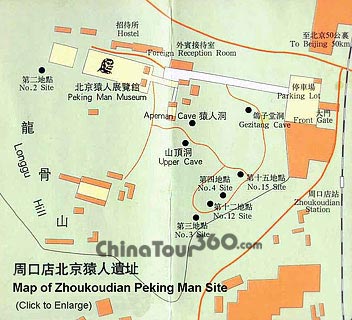 |
| Peking Man Site Map |
The Peking Man Site is just on the west side of Zhoukoudian Village, which is a small village, situated 50 kilometers (31 miles) southwest of Beijing. It is a large natural cave. Some 700,000 years ago, a species of Homo sapiens lived here for about 300,000 years, leaving several layers of ash as evidence of the use of fire. In addition, a number of stone tools were excavated here.
The site was discovered in 1921 by the Swede John Gunnar Andersson. Intensive excavation began in 1927. The site yielded nearly 200 pieces of Peking Man fossil (representing around 40 individuals), over 10,000 stone artifacts, several layers of ash as evidence of fire use, and more than 100 specimen of fossil animal. The site was listed by UNESCO as a World Heritage Site in 1987.
An important Paleolithic site, this site was first excavated in 1927, in a cave on Dragon Bone Hill at Zhoukoudian, southwest of Beijing. In December 1929, under the leadership of Chinese anthropologist Pei Wenzhong, a team from the Peking Institute of Geology excavated the first skull fossil of Peking Man. It was identified as being at least 690,000 years old. The two human-like teeth found before were not enough to convince everyone that they belong to Peking Man, but the skullcap gives more anatomical proof and was much more convincing.
In the following excavations, the most fruitful year was in 1936, three complete skullcaps were unearthed. In 1966, under the charge of Pei Wenzhong, a frontal, an occipital, and a tooth were found. A complete skullcap was reassembled with these newly unearthed skull fossils and the temporal bones excavated respectively in 1934 and 1936. They belong to the same individual. This is so far the only original specimen of the skullcap of Peking Man.
From 1921 to 1966, unearthed Peking Man fossils were six nearly complete crania or skullcaps, 19 large fragments of skulls, numerous small fragments of skulls, 15 incomplete mandibles, 157 isolated teeth, three pieces of humerus, one clavicular, one lunate, and a tibia. Besides Peking Man fossils, a lot of mammal fossils, artifacts, and ashes are also found at the site. They are excellent material for the study of human evolution and prehistory.
The study of geological strata indicates that Peking Man lived about 700, 000 to 200,000 years ago. The average brain volume of these people was 1,088 ml (the average for modern people is 1,400 ml). And it is estimated that their average height reached 156 centimeter (5.1 feet) for males and 150 centimeter (4.9 feet) for females.
Fossils of primitive men living 20,000 years ago were excavated in 1930 near the top of Dragon Bone Hill, and were named Upper Cave Man fossils. In 1973, fossils of New Cave Man were discovered. New Cave Man is believed to have lived in the period between Peking Man and Upper cave Man, suggesting a continuity of development. Peking Man was a cave dweller, tool maker, fire user, gatherer, and hunter. In view of fossil records and cultural remains, he was superb in his capability of adapting himself to environment with his adaption of physiological structure and technical ability.
![]() Entrance Fee: CNY 30
Entrance Fee: CNY 30
![]() Transportation: Take Bus No. 917 from Tianqiao to Liangxiang Ximen, and change to Bus No. 38 and get off at Zhoukoudian Site; Take Bus No. 917 (Zhangfang Branch Line) from Tianqiao to Zhoukoudian Cross and change to Bus No. 38 and get off at Zhoukoudian Site; Take Bus No. 616 from the Southern Square of Beijing West Railway Station to Lianxiang Ximen, and then change to Bus No. 38 and get off at Zhoukoudian Site.
Transportation: Take Bus No. 917 from Tianqiao to Liangxiang Ximen, and change to Bus No. 38 and get off at Zhoukoudian Site; Take Bus No. 917 (Zhangfang Branch Line) from Tianqiao to Zhoukoudian Cross and change to Bus No. 38 and get off at Zhoukoudian Site; Take Bus No. 616 from the Southern Square of Beijing West Railway Station to Lianxiang Ximen, and then change to Bus No. 38 and get off at Zhoukoudian Site.








